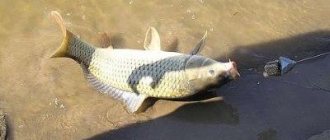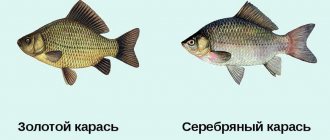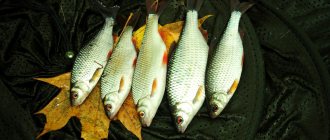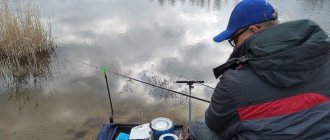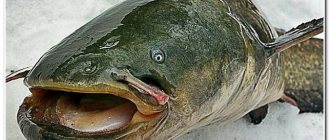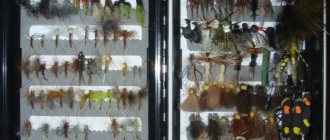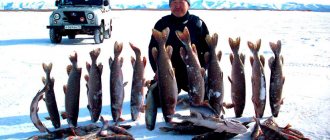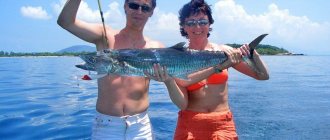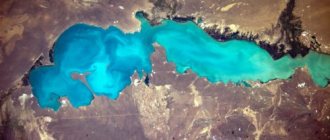The common nastus (lat. Chondrostoma nasus) is a medium-sized representative of the carp family, leading a gregarious lifestyle on the rocky, sandy, hard clay bottom of large and small rivers. The fish has pronounced biological feeding activity during daylight hours, and at night it prefers to rest in pits, snags, stone ridges, and dense bottom vegetation. Despite the daily waking schedule, catching undermouth is not an easy task due to the specific characteristics of the habitat, lifestyle and diet.
Description of the species
The standard size of representatives of the genus Chondrostoma is 25-30 cm with a weight of 400-500 g. Trophy specimens reach 1.2-1.5 kg (40-45 cm). The largest podust weighs 1.8-2.0 kg with a height of over 50 cm. But such individuals are extremely rare, since they reach their maximum dimensions at the end of life, which is 10-12 years.
The fish got its name from the lower terminal mouth (old mouth), located under the elongated cartilaginous snout, like a sturgeon. Another common nickname is the black belly, due to the special dark film on the inner walls of the abdominal cavity.
The main distinctive characteristics of the appearance of the undermouth include:
- body flattened laterally in the shape of a pointed ellipse;
- yellowish-orange pectoral, pelvic and anal fins;
- medium, tightly fitting silvery scales with a rounded posterior edge (cycloid type);
- dark olive color of the back, on which a smoky-gray fin is located (3 unbranched and up to 10 branched rays);
- low head with a flat nose and large eyes;
- clearly visible lateral line of dark color;
- black rim on the tail.
The color pattern and tone depend on the genus taxon, specific habitat conditions in the river and the season: during the spawning period, all orange, yellow and red shades on the fins of males become an order of magnitude brighter.
Volzhsky Podust
Latin name: Chondrostoma variabile. Listed in the Red Book of the Saratov Region as a “vulnerable species.” It is distinguished by its more modest size (up to 1.4 kg) and shorter life expectancy (up to 8-9 years). The lower jaw has a sharp end. There are 52-62 scales in the lateral line. The dorsal fins are greenish in color. It lives in tributaries and rivers of the European part of Russia (Volga, Don, Ural), also found in the Sura, Moscow River, Oka and large reservoirs (Kuibyshev, Volgograd, Saratov).
To learn more:
Types and description of marinka fish
Genoese (Western European) podust
The name in Latin is Chondrostoma genei. It lives in Italy, Slovenia, Austria, Belgium, France, Switzerland and in many rivers of the Adriatic and North Seas. The fish is distinguished by its yellow-green back and colorless fins. The lateral line runs through the entire strongly elongated body, but is poorly visible. Grows up to 35-40 cm (1.2-1.4 kg).
Dneprovsky Podust
The Latin name of the fish is Chondrostoma nasus nasus natio borysthenicum Berg. It has a moderately high body and a light, scaleless keel between the anal and ventral fins, colored red. Habitats are rivers, tributaries and reservoirs that form the basin of the Black and Azov Seas. Podust is especially numerous in the Dnieper and Southern Bug. Grows up to 1.5 kg (up to 45 cm).
General information
Podust
Latin name:
Chondrostoma nasus
Other names:
Blackbelly
Family:
Cyprinidae
Genus:
Podusts
Type:
freshwater
Lifestyle:
benthic
Diet type:
peaceful
Podust is part of the carp family. There are 18 varieties of it in freshwater bodies of Asia and Europe. Previously, this fish was common in Russia. It is very sensitive to water pollution. Nowadays it has become very rare, only in clean reservoirs with water saturated with oxygen. The lifespan of podust in clean water can reach up to 10 years. Popularity belongs to the common podust. Fishermen also call it blackbelly.
Habitats
The common podust has a rather limited range due to its attachment to warm, clean and oxygen-rich water, moderate currents and a hard bottom, near which it spends its entire life. That is why representatives of the carp family can only be found in lowland and mixed rivers with slow sections, large flowing reservoirs and lakes. In Russia, the black belly lives in the basins of the Caspian, Baltic and Azov seas, for example in the Western Dvina, Klyazma, Oka, Kama, Volga, Don, Kuban.
A school of fish usually consists of several dozen individuals of the same age and size, choosing a flowing area with depths of 1.5-3 meters as a permanent habitat. If there is a riffle on the river, the podust sites are located immediately above it and several tens of meters below, since there is the largest amount of the main food - periphyton fouling.
Periphyton organisms (obrogetes) are dense colonies of microscopic animals and plants (diatoms, green algae, bryozoans, insect larvae, rotifers, suctoria, ciliates, etc.), which require a solid substrate and a lot of sunlight for development. These circumstances determine the shallow depth of residence of the sub-dust and its attachment to the sandy-rocky bottom of the river.
The fish remains active from early morning until late evening. Even intense heat in August and frequent bad weather in September are not able to affect the usual schedule of the flock; it feels comfortable in the bottom layers regardless of any changes in the environment. Only in the cold autumn, when the volume of periphytic fouling decreases, does the undergrowth gradually slide down to the maximum depth in the river, where it overwinters in pits, next to other representatives of the cyprinid family.
To learn more:
The royal fish of the sturgeon family - sterlet
Float rod equipment for catching roach, bream and crucian carp
Equipping a winter fishing rod with a rig with a float allows you to easily switch from summer fishing to winter fishing, and does not require special, additional skills. With such tackle you can catch bream, white bream, silver bream, roach, crucian carp and perch.
Selection of equipment elements
For a winter float fishing rod, the following equipment is used:
- You can choose any fishing rod for a winter fishing rod, since this tackle is quite stationary, its weight does not matter much. It is advisable that the handle be made of cork, wood or other heat-insulating material, so that it does not get cold on your hands when fishing. It is also desirable to have legs or another stand. The rod whip should be flexible enough so that it does not cause the fish to break when hooking.
- The reel on a winter fishing rod can be of any type; its only purpose is to store fishing line.
- The fishing line is monofilament, preferably colored, which, unlike transparent, is easier to distinguish on ice or snow. As practice shows, for fish the color of the fishing line does not matter. As for the diameter of the main line, they recommend 0.15 - 0.18 mm, but here a lot depends on your preferences. Many fishermen complain that thin fishing line gets very tangled, and with a confident bite, the diameter does not matter much, and they prefer to fish with a fishing line of 0.2 - 0.25 mm.
- The leash can be made from either a thinner line or the same diameter as the main line.
- The floats used for winter fishing are quite varied. They are usually small in size and come in double, single and multi-piece types. They can be attached either using a cambric or clamps, or by passing a fishing line through a through hole, clamped with an antenna pin. Some of the most catchy winter floats are, for example, floats of light colors, conical shape, with a wide upper end. However, it all depends on the habits and preferences of the fisherman.
- The weights are selected in such a way that, when loaded, the float is several centimeters below the water level and does not freeze against the ice. The weight of the load itself depends on the float, the method of loading and the current at the fishing site.
- The size of the hook will primarily depend on the fish you are going to catch. It doesn't have to be small. The main thing is that it is thin.
I catch roach, bream, crucian carp, etc. A winter float fishing rod uses live bait - bloodworms, maggots, jigs, etc.
Check out the features of winter bream fishing
Installation of equipment
Installation of a winter float fishing rod is quite simple. For it, in addition to the previously listed equipment elements, we will need scissors and pliers.
- We measure the fishing line, its length should be equal to two depths of the reservoir at the fishing site, plus 2 - 3 meters. This value is needed so that you have a reserve of fishing line in case of a break.
- We wind the fishing line onto the reel.
- We pass the fishing line through the rings on the rod or attach a cambric, ring or other element to it for attachment to the tip of the fishing rod.
- Then we pass the fishing line through the hole in the float or put on an element that secures the fishing line to the float.
- The next step is loading the float. First, the main weight is attached to the fishing line, giving the float almost zero buoyancy. Below it we place a very small weight, which will submerge our float, and when lifted, the float will float up.
- Below the small weight, approximately 5 - 7 cm, we tie a hook, either on a leash, or directly to the main fishing line. In the second case, you need to make a knot on the fishing line just below the load, where the fishing line will break if it gets caught. Otherwise, we risk losing most of the gear, and not just the hook.
That's it, the winter fishing rod is ready for use
Reproduction
Podust spawning occurs in the first half of spring, at a water temperature not lower than +8-10°C. Mature males, starting from 3-4 years of age, participate in the process of spawning. Females mature 1-2 years longer. Shallow water with a pebble or sandy bottom is chosen as a spawning ground.
Fish spawning is one-time and occurs in the morning or evening twilight. The clutch contains from 2 to 12 thousand large whitish eggs, the incubation period of development is 10-14 days. After hatching, they intensively feed on plankton in the water column for several months. Having become a fry, the podust switches to a bottom lifestyle and begins to eat detritus, benthos, and periphyton fouling, scraping them off stones, snags, and aquatic vegetation.
Fishing locations and biting times
Maximum food activity occurs in the morning and evening. During the day, the fish becomes calmer and more cautious, although it continues to feed.
When choosing a place for fishing underwater, you must immediately exclude sections of the river with a muddy bottom, too slow a flow and blooming water. The rapid proliferation of phytoplankton, which turns everything green, is a clear indicator of stagnant water with oxygen deficiency.
Promising places for catching podust are shallow riffles, sandy, pebble edges on the border of a fast current, shallow water near a steep bank, areas with stone ridges and piles of snags. Blackbelly often lives in close proximity to artificial structures installed in the water and bridge piles, where huge colonies of periphyton organisms live.
How and what to catch podust
Almost all methods of fishing for bottom fish in the current are suitable, but fishing with a float rod using the retrieving method is considered the most interesting and effective.
Despite its modest size, the podust is distinguished by great strength and endurance, so the equipment should be light, but withstand powerful jerks.
The optimal gear parameters look like this:
- a rod with a fast action, 3.0-3.5 meters long;
- inertial coil;
- main line – 0.22-0.25 mm (with breaking load from 3 kg);
- leashes – 0.16-0.2 mm;
- hooks with a short shank No. 10-5 (international numbering) or No. 5-8 (standardization of the Russian Federation).
To learn more:
Types of carp: mirror, koi and others
Due to constant feeding at shallow depths, the blackbelly is quite bold and comes close to fishermen's boats. But noises from the shore alarm him; here it is better to use long-range gear.
Fishing on a feeder
Rods with a length of 3.5-3.9 m with a medium-fast action and a cast of up to 120 g are used. For long casts from 40-45 m, a braided cord of 0.12-0.15 mm is wound on a spinning reel with a spool capacity of 3000-4000. For fishing at a distance of up to 40 meters, you can use 0.22-0.25 mm monofilament.
For fishing undermouth in the spring and from September to October, it is wise to use an asymmetrical loop. It provides better visualization of the bite and free movement of the feeder at a distance of 30-60 cm, which allows cautious fish to swallow the bait deeper without any resistance from the gear. Fishing for subdust in June, July and August does not require complex equipment; either a symmetrical loop or any other feeder installation will do. In addition, you can use classic donks without a feeder.
Spinning fishing
Despite its herbivorous nature, podust responds well to artificial moving baits, especially in the fall. Small spoons, spinners, wobblers and silicone baits designed for catching chub, ide, asp are suitable - Blue Fox Super Vibrax, Forest Crystal, Strike Pro, BJ-Bug. In this case, the spinning retrieve must be slow enough so that the fish has time to grab it with its low mouth.
Peculiarities of undergrowth behavior in autumn
Podust flocks concentrate in places with a natural food supply. In the first half of autumn, the fish are highly active. Podust fishing in September is the most promising. In October and November, the undermouth bite worsens. But this does not mean that catching it during these months is hopeless. Podust fishing is also possible in winter.
In cold water, the bait will approach the baited area when the complementary food is in close proximity. Therefore, you need to deliver bait to several promising places, and then fish them one by one or use several gears at the same time.
Baits and lures
The black belly has an excellent appetite; it readily eats animal and plant foods. The following can be used as a catch bait for the undermouth:
- dough, bread crumb, boiled peas;
- steamed grains, pearl barley, snail meat;
- mastyrka, bloodworms, maggots;
- earthworm and dungworm;
- honeydew, bark beetle larva, bunch of filamentous algae;
- caddisfly, a piece of crawling, large ant eggs.
It is not recommended to use hooks with a long shank for fishing, since then the fish cannot completely swallow the bait. At the moment of hooking, the sting of the hook simply slides off the hard lips of the undermouth or pierces only their edge, which is not enough for successful fishing.
To learn more:
What is included in Minenko boilies?
How to catch podust.
What gear is used for catching podust.
- Float gear. All types of rods are used: fly rods, Bolognese rods, match rods.
- Bottom gear.
- Spinning.
- Feeder.
Method of catching undermouth.
The main method of fishing is from a boat using a wire. The optimal depth for fishing is from one and a half to two and a half meters.
When to catch podust.
They begin to catch podust at the end of May, after its spawning. It is worth noting that in the summer it continues to bite well, despite the heat, while other fish stop being caught. You can catch it almost all daylight hours. However, the bait bites best about two hours after sunrise. By eleven o'clock in the morning the bite noticeably subsides and resumes only at two to four o'clock in the afternoon. By the evening he bites a little worse than in the morning, since usually by this moment he is already full.
Lure.
The success of fishing largely depends on bait. Steamed bran and ant eggs are excellent bait. Various cereals are also used as bait, such as millet, buckwheat, pearl barley, and Hercules. It would be a good idea to flavor the porridge with sunflower or linseed oil. To prevent the bait from being washed away by the fast current, it is mixed with clay and rolled into balls. Dregs and crumbs attract pods well.
What is the best way to catch podust?
To the question: “What is the best way to catch podust?” there is no clear answer. On different rivers, fish behave differently. It all depends on what kind of food in a given body of water she is accustomed to. In some reservoirs these are mayfly larvae and amphipods, in others – caddis flies, and in some places – bark beetles.
The choice of nozzle also depends on the season. So, at the end of spring, the podust bites well on large ant eggs. In summer, it is mainly caught with a worm or even with pieces of a worm. It may also be caught on bread, millet or pearl barley, but much less often, since it prefers natural food. In the fall they catch them with bloodworms, maggots and pieces of worms. Considering that the mouth of the mouth is small, the nozzle should be small in volume.
Technique on how to catch podust.
The bites under the mouth are gentle, he takes the bait carefully, holding the bait with his cartilaginous lips and without swallowing for a long time. And in weak currents it can be difficult to distinguish whether it’s a bite or whether the bait is caught on the bottom. On rapids, the bite is more pronounced, as the float suddenly goes under the water. You need to hook quickly and energetically, otherwise the underwater fish may have time to spit out the bait. It gets off the hook quite often, especially among novice fishermen.
The cut undergrowth resists furiously. He makes a sharp, strong jerk in the direction opposite to the sweep. If it was not possible to free himself immediately, he begins to shake his head and walk in a zigzag pattern near the bottom, periodically making sudden movements and performing sharp turns. Often he manages to get himself off the hook. However, the bait, freed from the hook, may soon approach the bait again and again fall into the hands of the fisherman.
The importance of groundbait
The result of catching undermouth directly depends on the fisherman’s ability to form a stable cloud of food turbidity, as well as a fragrant trail spread by the river current. There is no need for culinary delights - the fish reacts to flour, crackers, bran, boiled peas, millet, crushed biscuits, cereals, and barley. One of the most attractive baits is buckwheat with the addition of garlic, coriander, and vanilla flavor enhancers.
Store-bought baits are widely used for other representatives of the carp family, for example, FISH DREAM “Universal”, DUNAEV “Feeder”. Crucian carp", "Volzhanka. Roach", GF "Feeder. Bream".
Before fishing, you need to feed the bait in advance or immediately after arriving at the reservoir. If the weather is cool, it is advisable to add additional ingredients of animal origin: chopped worms, bloodworms, maggots. In order not to scare away the fish, it is advisable to give the mixture a sandy-clay tint. You can use cinnamon or turmeric for this.
Hooking and landing
Podust is caught well from late spring to October, showing various types of bite. He can suck on the pearl barley for a long time and then smoothly lay out the float, sharply grab the worm and instantly drag the entire tackle under water. But no matter how the float antenna or the tip of the rod behaves, at the right moment it is necessary to perform a sharp and strong hook in order to reliably drive the hook into the hard lips of the fish.
During fishing, the undermouth actively resists, demonstrating a strength that is surprising for such small dimensions, which makes fishing interesting and tempting. Since this fish is often caught in places rich in snags and aquatic vegetation, it is important to constantly monitor the tension of the fishing line and not allow the trophy to hide in cover. In order not to be left without a catch at the last moment, you need to use a landing net.
Fishing for podfish in summer
At the beginning of summer, after spawning, the podust immediately rolls down to the lower reaches, and it is very difficult to catch it. A good catch can only be obtained when all the vegetation is in bloom. Most podusts feed near pebbly and rocky places. The reason is that the stones are overgrown with algae, which is the main food of this small fish.
But fishing here is not fruitful. Due to the stones and the crevices they form, fishing is accompanied by constant snags, and the bait is ineffective. And bait is very important when fishing for bait.
Podust is best caught near clay steep yars . You need to look for places where you can reach the bottom, since this is where the underdust floats. It’s good if the bottom is without unevenness. Then there will be no snags.
If you can’t find the most suitable place or don’t want to, you need to fish with a plug or half-bottom. A feeder is also suitable if the fisherman has sophisticated technique.
He is constantly in search of food. Therefore, and also because of the variable current, it moves all the time. Since algae grows very quickly, fish visit their site every day. And this happens during the daytime.
We can conclude that the ideal position of the fisherman is upstream from the school of feeding pods. This way the fish will swim straight into the net.
This article will teach you how to make a mandula for pike perch with your own hands.
And here you will see trophies and records of December IGFA fishing.
Taste qualities of the podust
Blackbelly fish taken from natural conditions quickly die and deteriorate, so it is important to use a long cage and process the fish immediately.
In terms of consumer characteristics, nutritional value and culinary versatility, podust is inferior to carp, ide, bream and is quite bony. To prepare aromatic dishes, frying, baking in foil, hot and cold smoking are used. Due to its moderate calorie content (104 kcal per 100 g) and low fat content (4.3%), podust is well suited for dietary nutrition.
